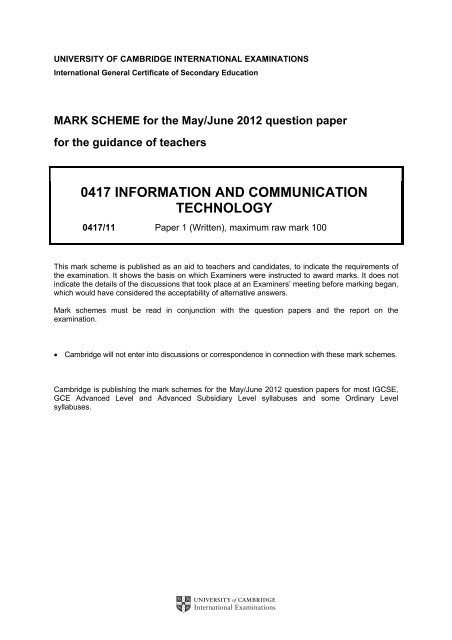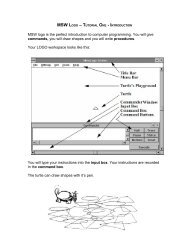June 2012 Paper 1 Mark Schema
June 2012 Paper 1 Mark Schema
June 2012 Paper 1 Mark Schema
You also want an ePaper? Increase the reach of your titles
YUMPU automatically turns print PDFs into web optimized ePapers that Google loves.
UNIVERSITY OF CAMBRIDGE INTERNATIONAL EXAMINATIONS<br />
International General Certificate of Secondary Education<br />
MARK SCHEME for the May/<strong>June</strong> <strong>2012</strong> question paper<br />
for the guidance of teachers<br />
0417 INFORMATION AND COMMUNICATION<br />
TECHNOLOGY<br />
0417/11 <strong>Paper</strong> 1 (Written), maximum raw mark 100<br />
This mark scheme is published as an aid to teachers and candidates, to indicate the requirements of<br />
the examination. It shows the basis on which Examiners were instructed to award marks. It does not<br />
indicate the details of the discussions that took place at an Examiners’ meeting before marking began,<br />
which would have considered the acceptability of alternative answers.<br />
<strong>Mark</strong> schemes must be read in conjunction with the question papers and the report on the<br />
examination.<br />
Cambridge will not enter into discussions or correspondence in connection with these mark schemes.<br />
Cambridge is publishing the mark schemes for the May/<strong>June</strong> <strong>2012</strong> question papers for most IGCSE,<br />
GCE Advanced Level and Advanced Subsidiary Level syllabuses and some Ordinary Level<br />
syllabuses.
Page 2 <strong>Mark</strong> Scheme: Teachers’ version Syllabus <strong>Paper</strong><br />
IGCSE – May/<strong>June</strong> <strong>2012</strong> 0417 11<br />
1 A Microphone [1]<br />
B Webcam [1]<br />
C Remote control [1]<br />
D Number pad [1]<br />
2 buzzer DVD R joystick [1]<br />
3<br />
4<br />
magnetic tape plotter touch pad [1]<br />
© University of Cambridge International Examinations <strong>2012</strong><br />
True False<br />
A scanner is used to enter a PIN <br />
Word processing software is used to write letters <br />
Database software is used to create newspapers <br />
A command line interface uses icons to represent applications <br />
Sensors are used to monitor physical variables <br />
Abnormal Extreme<br />
20 <br />
21 <br />
twenty <br />
0 <br />
[5]<br />
[4]
Page 3 <strong>Mark</strong> Scheme: Teachers’ version Syllabus <strong>Paper</strong><br />
IGCSE – May/<strong>June</strong> <strong>2012</strong> 0417 11<br />
5 Three pairs from:<br />
Hub<br />
Broadcasts data packets to computers in a LAN<br />
6<br />
Router<br />
Connects LANs to a WAN/Internet<br />
Switch<br />
Directs data packets to specific computers<br />
NIC<br />
Enables computers to be connected to a network<br />
Bridge<br />
Connects networks/LANs together/Directs data packets to specific networks<br />
Proxy server<br />
Stores web pages for faster re-use by computers/can act as a firewall<br />
Modem<br />
Modulates data and demodulates phone signals [6]<br />
© University of Cambridge International Examinations <strong>2012</strong><br />
LAN WLAN<br />
Uses wireless technology to transmit data <br />
Faster transmission of data <br />
Greater security <br />
Is cheaper as there is less cabling <br />
7 PEN DOWN FORWARD 300<br />
RIGHT 90 PEN DOWN<br />
REPEAT 8 REPEAT 6 b<br />
FORWARD 100 FORWARD 80<br />
LEFT 45 LEFT 60<br />
END REPEAT END REPEAT<br />
PENUP<br />
1 mark for each correct statement [8]<br />
[4]
Page 4 <strong>Mark</strong> Scheme: Teachers’ version Syllabus <strong>Paper</strong><br />
IGCSE – May/<strong>June</strong> <strong>2012</strong> 0417 11<br />
8 A blu ray disc is used to store high definition copies of movies<br />
A graphics tablet is used to retouch photographs<br />
An inkjet printer is used to print out photographs<br />
A motor is used to open windows in a greenhouse<br />
An Optical <strong>Mark</strong> Reader is used to input candidate examination answers [5]<br />
9 Three from:<br />
If computer is switched off work in RAM goes but backing storage stores data for future use<br />
More likely that data is accidentally deleted in RAM<br />
RAM is more expensive than backing storage per unit of memory<br />
RAM is bulkier than backing storage per unit of memory<br />
RAM provides faster access than backing storage<br />
Software package may be so large that it is physically impossible for RAM to store it.<br />
Data may need to be transferred from one computer to another and can’t do that with RAM [3]<br />
10 (a) Three from:<br />
Temperature sensor<br />
Light sensor<br />
pH sensor<br />
O2 sensor<br />
CO2 sensor [3]<br />
(b) Five from:<br />
The sensors feed back data to microprocessor/computer<br />
Data is converted from Analogue to Digital<br />
Readings from A are compared with those from B...<br />
.....by the computer/microprocessor<br />
Differences are printed out<br />
Graphs are automatically produced by computer showing values from A and B..<br />
...plotted against time<br />
Process is continuous. [5]<br />
11 (a) Four from:<br />
User interface<br />
Rules base<br />
Knowledge base<br />
Inference engine [4]<br />
(b) Two from:<br />
Engine car fault diagnosis<br />
Prospecting<br />
Tax<br />
Careers<br />
Chess games<br />
Animal/plant classification [2]<br />
© University of Cambridge International Examinations <strong>2012</strong>
Page 5 <strong>Mark</strong> Scheme: Teachers’ version Syllabus <strong>Paper</strong><br />
IGCSE – May/<strong>June</strong> <strong>2012</strong> 0417 11<br />
12 Three pairs from:<br />
Length check<br />
Checks there are exactly 16 characters<br />
Invalid character/type check<br />
Checks all characters entered are digits<br />
Check digit<br />
Single digit calculated from other digits appended to these, computer carries out fresh calculation<br />
on digit and compares answer with original check digit.<br />
Existency check<br />
Is the card number on the database [6]<br />
13 RSI in the wrists – caused by repetitive typing/prolonged gripping of mouse [1]<br />
RSI in the fingers – caused by repetitive clicking of mouse [1]<br />
Headaches – staring at the screen for too long [1]<br />
Back pain – sitting in the same position for long periods [1]<br />
14 Three matched triples from:<br />
User ID and password<br />
Benefit – each user ID could be unique/only user will know the password/data can only be<br />
accessed by person who knows the password/Password can be changed frequently to avoid<br />
hackers guessing them/Unsuccessful logins can throw you out of the system<br />
Drawback – user might forget password/keylogging software can be used to intercept it<br />
Biometrics<br />
Benefit – each user has unique biometrics<br />
Drawback – equipment is expensive to buy/may be difficult or expensive to get equipment to user<br />
Magnetic/chip card with PIN<br />
Benefit – Hacker needs to have the card and know the PIN<br />
Drawback – can lose the card/can forget PIN<br />
TAN<br />
Benefit – Always changing so a hacker would not be able to use it even if they intercepted it when<br />
user typed it in.<br />
Drawback – need to have card and remember PIN and use it within a short period of time. [9]<br />
© University of Cambridge International Examinations <strong>2012</strong>
Page 6 <strong>Mark</strong> Scheme: Teachers’ version Syllabus <strong>Paper</strong><br />
IGCSE – May/<strong>June</strong> <strong>2012</strong> 0417 11<br />
15 (a) Would always be the same contents/waste space putting in duplicated field [1]<br />
(b)<br />
Field name Validation check<br />
Model Must be Feisty or Mendo or Galactica<br />
Colour Must be red, blue or gold<br />
Air conditioning Boolean check - Must be yes or no<br />
Number of doors Range check >2 AND =3 AND
Page 7 <strong>Mark</strong> Scheme: Teachers’ version Syllabus <strong>Paper</strong><br />
IGCSE – May/<strong>June</strong> <strong>2012</strong> 0417 11<br />
(e) Four from:<br />
Benefits<br />
Real thing may be too expensive to build<br />
Real thing requires too large a time scale<br />
Real thing would be too wasteful of materials<br />
Real thing is too vast a scale<br />
Easier to change data/variables<br />
Costs less to change data/variables<br />
The real thing may be impossible to access/create<br />
Real thing may be too dangerous<br />
You can test predictions more easily/model can make predictions more accurately<br />
you can ask many whatif questions which would be impractical in real life<br />
Drawbacks<br />
Can never allow for all eventualities<br />
Difficult to exactly recreate a lifelike situation<br />
Hardware and software may be expensive<br />
Workers will need to be trained to use the system<br />
Max. 3 drawbacks or benefits [4]<br />
© University of Cambridge International Examinations <strong>2012</strong>



